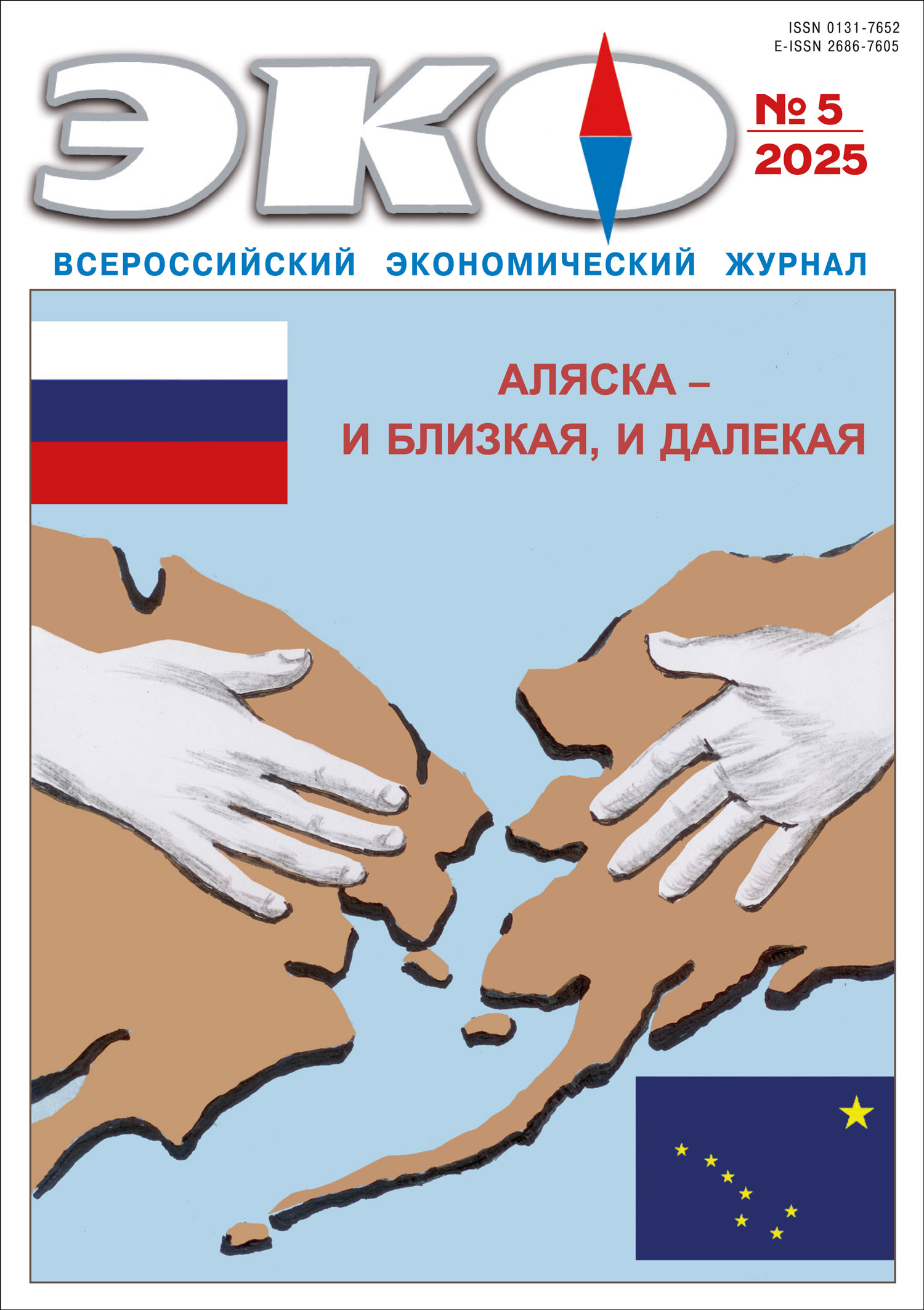ECOLOGY AND ECONOMY
Environmental consequences of economic growth in the Republic of Sakha (Yakutia) in 2000–2022
Published 2025-10-06
Keywords
- Republic of Sakha (Yakutia); structural shifts; economic growth; environmental intensity; Environmental Kuznets Curve
How to Cite
1.
Krasilnikova Н, Savvin Э, Gavrilyeva Т. Environmental consequences of economic growth in the Republic of Sakha (Yakutia) in 2000–2022. ECO [Internet]. 2025 Oct. 6 [cited 2025 Dec. 13];55(5):239-56. Available from: https://ecotrends.ru/index.php/eco/article/view/4908
Abstract
The paper analyzes the relationship between economic growth and the intensity of environmental load in the Republic of Sakha (Yakutia) in 2000–2022. Comparison of recovery and stabilization periods of the economy (2000–2008) and the newest wave of industrial development (2009–2022) showed that in recent years the GRP growth rate of the Republic due to intensive development of extractive industries exceeded the national rates, but a number of industries stagnated. Shifts in the sectoral structure of the economy determine the scale of anthropogenic load on the environment. Unlike the Russian Federation as a whole, the volume of atmospheric emissions and the rate of production waste generation are growing. The hypothesis of the Kuznets environmental curve was tested for carbon monoxide (CO), sulfur dioxide (SO2) and nitrogen dioxide (NO2) emissions in the region and did not find confirmation. One of the reasons is insufficient share of investments in environmental protection in the structure of investments in fixed capital.References
- Аганбегян А.Г. Возможный сценарий будущего: двухэтапное социально-экономическое развитие России до 2030–2035 гг. // Научные труды ВЭО России. 2023. Т. 244. № 6. С. 228–260. DOI: 10.38197/2072–2060–2023–244–6–228–260
- Гаврильева Т.Н., Петров Н.А., Ноговицын А.В., Павлов Н.В. Эмиссия парниковых газов в Якутии: ретроспективный анализ на основе топливно-энергетического баланса // ЭКО. 2018. № 6. C. 118–135. DOI: 10.30680/ЕСО0131–7652–2018–6–118–135
- Гребнева Е.С., Моренец О.В. Тестирование кривой Кузнеца в регионах России, выявление факторов, определяющих рост загрязнения окружающей среды // Жизнеспособность экономических теорий: проверка порядком и хаосом: сборник статей. Лаврикова Ю.Г., Мыслякова Ю.Г., Бучинская О.Н. (ред.). Екатеринбург: Институт экономики УРО РАН, 2022. C. 212–230. DOI: 10.31063/EASET/2022/Grebneva.ES-18
- Дружинин П.В., Шкиперова Г.Т., Поташева О.В. Исследование взаимосвязи экологических и экономических показателей: моделирование и анализ расчетов / Oтв. ред. П.В. Дружинин. Институт экономики КарНЦ РАН. Петрозаводск. 2019. 127 с.
- Иванова В. ВРП и загрязнение окружающей среды в регионах России: пространственно-эконометрический анализ // Квантиль. 2019. № 14. С. 53–62.
- Мельникова Л.В. Пространственный анализ динамики структурных сдвигов в экономике российских регионов в 2004–2019 гг. // Регион: экономика и социология. 2021. № 3 (111). С. 54–79. DOI: 10.15372/REG20210303
- Михалищев С., Раскина Ю. Экологическая кривая Кузнеца: случай России. Европейский университет в Санкт-Петербурге, Факультет экономики. Препринт Ec-03/15, 34 с. URL: https://eusp.org/sites/default/files/archive/ec_dep/wp/Ec-03_15.pdf
- Саввинов Г.Н., В.С. Макаров В.С., Величенко В.В. Экосистемы Якутской Арктики: современные вызовы и угрозы // Проблемы региональной экологии. 2023. № 2. С. 63–73. DOI: 10.24412/1728–323X-2023–2–63–73
- Шкиперова Г.Т. Экологическая кривая Кузнеца как инструмент исследования регионального развития // Экономический анализ: теория и практика. 2013. № 19 (322). С. 8–16.
- Baek, J. (2015). Environmental Kuznets Curve for CO 2 emissions: the case of Arctic countries. Energy Economics. Vol. 50. July. Pp. 13–17. DOI: 10.1016/j.eneco.2015.04.010
- Gavrilyeva, T., Sugimoto, A., Bochkarev, N., Stepanova (Krasilnikova), N., Nogovitcyn, A., Semenova, L. (2020). Economy-related green-house gases emissions and validation of the Environmental Kuznets Curve for Sakha Republic (Yakutia). Polar Science. 23:100507. DOI: 10.1016/j.polar.2020.100507
- Kilinc-Ata, N., Likhachev, V.L. (2022). Validation of the environmental Kuznets curve hypothesis and role of carbon emission policies in the case of Russian Federation. Environmental Science and Pollution Research. No. 29. Pp. 63407–63422. DOI: 10.1007/s11356–022–20316–9
- Lantz, V., Feng, Q. (2006). Assessing income, population, and technology impacts on CO2 emissions in Canada: Where’s the EKC? Ecological Economics. Vol. 57, Issue 2, 1 May. Pp. 229–238. DOI: 10.1016/j.ecolecon.2005.04.006
- Leigh, Nancey Green (2013). Planning Local Economic Development. Sage Publications. Pp. 174–175. ISBN9781452242590
- Panayotou, T. (1993). Empirical Tests and Policy Analysis of Environmental Degradation at Different Stages of Economic Development / Geneva, Switzerland: International Labour Office. Working Paper. WP238.
- Rudenko, D. (2018) Environment and economic growth in the Russian Arctic. International Journal of Global Environmental Issues (IJGENVI). Vol. 17. No. 2/3. Pp. 163–174. DOI: 10.1504/ijgenvi.2018.10012372
- Yang, X., Lou, F., Sun, M., Wanga, R., Wang, Y. (2017). Study of the relationship between greenhouse gas emissions and the economic growth of Russia based on the Environmental Kuznets Curve, Applied Energy. Vol. 193. May. Pp. 162–173. DOI: 10.1016/j.apenergy.2017.02.034

